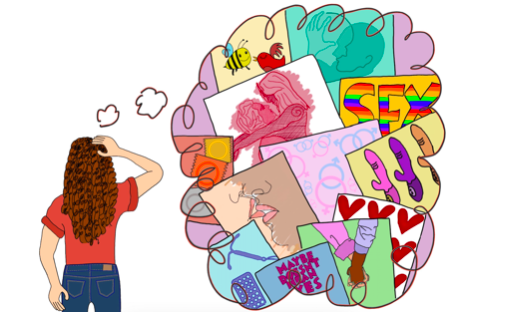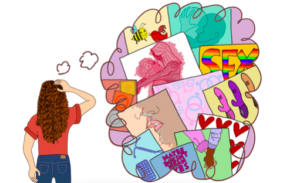*Warning: Mentions of abusive relationships*
Whenever I go in for my annual physical, I get asked the same questions:
“Are you sexually active?”
“Yes.”
“Do you use protection?”
“No.”
The doctor always looks a little puzzled, believing I just openly admitted to not using birth control and was playing Russian roulette with getting pregnant. I quickly say “I have a girlfriend and we’ve been dating for two years,” and the doctor lets out a sigh of relief. But, it’s still always me that has to bring up the possibility of dating a woman; I’m never asked what gender my partner is. It’s always assumed to be a man. This conversation has happened several times at this point and while I’d do it again, it does feel mildly frustrating that the definition of “sex” is still presumed to be PIV, penis-in-vagina.
When I took sex ed at 14, PIV was the main point of interest. The priority of the North Carolina education system sex ed curriculum was, and still is, to make sure students don’t get accidentally pregnant. It’s a noble and important cause, but omits anything regarding non-hetero sexuality. For example, “sex” as an act is up for interpretation. If it’s not just relegated as PIV, then what else is “sex?” Well, in my opinion, it’s up for the consenting individuals to decide. But, it’s definitely not just PIV, and children should be taught more about sex than just the act of PIV.
Primarily, the goal of sex education should not just be subtitled “How to Not Get Pregnant,” but rather as much as you can fit into a week-long course that will come in handy for when teenagers become sexually active, including queer relationships and healthy relationship dynamics.
Currently, NC Sex Education is relatively passive with its first instruction. First off, parents can deny their children in-school sex ed by signing a release, leaving it up to the parents if a child receives any kind of sex education. This “loophole” makes it particularly easy for sex-negative parents to teach abstinence above all else and can lead to all kinds of misconceptions about sex. In addition, the curriculum currently requires that educators stress the “benefits of abstinence.”
Three things in life are certain —life, death, and teenagers having sex. So, let’s not pretend abstinence is the answer.
To take it one step further, educators are required to state that “a mutually faithful monogamous heterosexual relationship in the context of marriage is the best lifelong means of avoiding sexually transmitted diseases, including HIV/AIDS.” In reality, the best way to avoid contracting an STD is to get tested before each new partner and wear protection regularly. In addition, the viewpoint that hetero relationships are the “safest” also demonizes and stigmatizes queer relationships. Contrary to popular belief, HIV/AIDS is not restricted to queer people and hetero partners are not exempt from spreading HIV/AIDS. By falsely emphasizing that heterosexual couples, even in the context of “perfect” monogamy, cannot spread sexually transmitted diseases, it presents an image that queer relationships are inherently less fulfilling than heterosexual relationships and are more likely to spread disease.
Despite the repetition of praising heterosexual relationships, the curriculum leaves out anything about queer relationships, in the context of both sexual and romantic relationships. There’s no discussion of what queer sex looks like physically, or how to use protection, such as female condoms, in same-sex partnerships to prevent the spread of infections. This leaves many teenagers left in the dark about sexually transmitted infections and diseases. And while the curriculum does require instructors to discuss STIs/STDs, the state-designated agenda leaves a lot open for interpretation, meaning the instructor can decide which infections and diseases they discuss and for how long.
To make things worse, schools are banned from distributing one of the safest and easiest modes of contraception — condoms. There’s already a widespread issue of men claiming condoms affect performance, and it’s still an uphill battle for public health administrators to encourage couples to use condoms, so banning any kind of condom distribution only discourages people further from using them as protection. Condoms are applicable for not only heterosexual partners to avoid pregancy, but also for hetero and gay partners to prevent STIs and STDs. Students will be having sex while in high school and it’s important that they have access to contraception early, not just to slow the spread of any infections, but also to create good habits going forward so they continue to wear condoms, even if they’re not available in the nurse’s office.
There brief is discussion of sexual assault in the curriculum, but nothing about abuse in relationships, either physical or emotional. This is a disadvantage to both straight and queer people. While abusive hetero relationships are somewhat common in media, they primarily only cover physically abusive relationships, and it usually feels as if it’s only for shock value. In addition, these representations are usually limited to a physical power imbalance — a tall, strong man in contrast to a smaller woman. This narratives leaves out queer relationships, or any relationships where the woman may be the abuser, and importantly leaves out emotionally abusive dynamics. It’s important to discuss every aspect of relationships during sex ed so students can later down the line distinguish a good, healthy relationship from an abusive one. These topics are not limited to any sexuality or gender identity and can benefit every student.
Finally, I think North Carolina should include an acceptance of queer identity in its curriculum. Not necessarily a flow-chart titled “How to Know if You’re Queer,” but rather to explain that it’s okay to be queer and to have a gender identity and sexuality that is not cis or hetero. And while Gen Z is quickly becoming the most out-and-proud generation, it’s important that sexuality and gender identity are included in the sex ed curriculum of the state to show unwavering support for students.
For North Carolina students, a curriculum that is dependent on abstinence not only leaves room for unsafe and unprotected sex, but creates an overwhelming sex-negative environment and leaves more confusion than answers. It leaves out discussions about queer identity, healthy relationships, and safe sex. Not only is the current curriculum inadequate, but it fails to prepare students for any kind of experience that does not include abstinence. It creates confused and anxious teenagers who rely on Google for answers about sex and relationships. Currently, no one, especially queer kids, benefit from the current sex ed curriculum in North Carolina.
 Claire Goray graduated from UNC-Chapel Hill in May 2020 with a major in American Studies and minors in Writing for the Screen & Stage and Sexuality Studies. Her interests include representation in film & media, examining the HIV/AIDS crisis, and studying the importance of historical monuments.
Claire Goray graduated from UNC-Chapel Hill in May 2020 with a major in American Studies and minors in Writing for the Screen & Stage and Sexuality Studies. Her interests include representation in film & media, examining the HIV/AIDS crisis, and studying the importance of historical monuments.


There are no comments
Add yours